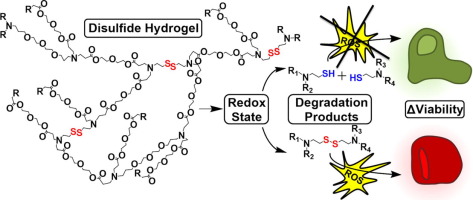Acta Biomaterialia ( IF 9.4 ) Pub Date : 2017-12-28 , DOI: 10.1016/j.actbio.2017.12.030 Andrew L. Lakes , Carolyn T. Jordan , Prachi Gupta , David A. Puleo , J. Zach Hilt , Thomas D. Dziubla

|
Recently, biomaterials have been designed to contain redox-sensitive moieties, such as thiols and disulfides, to impart responsive degradation and/or controlled release. However, due to the high sensitivity of cellular redox-based systems which maintain free-radical homeostasis (e.g. glutathione/glutathione disulfide), if these biomaterials modify the cellular redox environment, they may inadvertently affect cellular compatibility and/or oxidative stress defenses. In this work, we hypothesize that the degradation products of a poly(β-amino ester) (PBAE) hydrogel formed with redox sensitive disulfide (cystamine) crosslinking could serve as a supplement to the environmental cellular antioxidant defenses. Upon introduction into a reducing environment, these disulfide-containing hydrogels cleave to present bound-thiol groups, yet remain in the bulk form at up to 66 mol% cystamine of the total amines. By controlling the molar fraction of cystamine, it was apparent that the thiol content varied human umbilical vein endothelial cell (HUVEC) viability IC50 values across an order of magnitude. Further, upon introduction of an enzymatic oxidative stress generator to the cell culture (HX/XO), pre-incubated thiolated hydrogel degradation products conferred cellular and mitochondrial protection from acute oxidative stress, whereas non-reduced disulfide-containing degradation products offered no protection. This polymer may be an advantageous implantable drug delivery system for use in acute oxidative stress prophylaxis and/or chronic oxidative stress cell therapies due to its solid/liquid reversibility in a redox environment, controlled thiolation, high loading capacity through covalent drug-addition, and simple post-synthesis modification which bound-thiols introduce.
Statement of Significance
In this work, we demonstrate a unique property of disulfide containing degradable biomaterials. By changing the state of the oxidation state of the degradation products (From oxidized to reduce) it is possible to increase the LD50 of the material by an order of magnitude. This dramatic shift is linked directly to the oxidative stress response of the cells and suggests a possible mechanism by which one can tune the cellular response to degradable biomaterials.
中文翻译:

可还原的二硫化物聚(β-氨基酯)水凝胶用于抗氧化剂的输送
近来,已经设计了生物材料以包含对氧化还原敏感的部分,例如硫醇和二硫化物,以赋予响应性降解和/或控制释放。然而,由于维持自由基动态平衡的基于细胞氧化还原的系统(例如,谷胱甘肽/谷胱甘肽二硫化物)具有很高的敏感性,如果这些生物材料改变了细胞氧化还原环境,它们可能会无意中影响细胞相容性和/或氧化应激防御。在这项工作中,我们假设氧化还原敏感的二硫键(胱胺)交联形成的聚(β-氨基酯)(PBAE)水凝胶的降解产物可以作为环境细胞抗氧化剂防御的补充。引入还原环境后,这些含二硫键的水凝胶会裂解形成结合的硫醇基团,但仍以散装形式保留,占总胺类的高达66 mol%的胱胺。通过控制胱胺的摩尔分数,很明显,巯基含量改变了人脐静脉内皮细胞(HUVEC)的生存能力跨一个数量级的50个值。此外,在将酶促氧化应激发生器引入细胞培养物(HX / XO)后,预先孵育的硫醇化水凝胶降解产物可赋予细胞和线粒体免受急性氧化应激的保护,而未还原的含二硫化物的降解产物则无法提供保护。由于该聚合物在氧化还原环境中具有固/液可逆性,可控制的硫醇化,通过共价药物添加的高负载能力,以及由于其在氧化还原环境中的固/液可逆性,因此该聚合物可能是用于急性氧化应激预防和/或慢性氧化应激细胞治疗的有利植入式药物输送系统。结合硫醇引入的简单的合成后修饰。
重要声明
在这项工作中,我们证明了含二硫化物的可降解生物材料的独特性能。通过更改降解产物的氧化态(从氧化到还原),可以将材料的LD50提高一个数量级。这种剧烈的变化直接与细胞的氧化应激反应有关,并暗示了一种可能的机制,通过该机制人们可以调节细胞对可降解生物材料的反应。











































 京公网安备 11010802027423号
京公网安备 11010802027423号